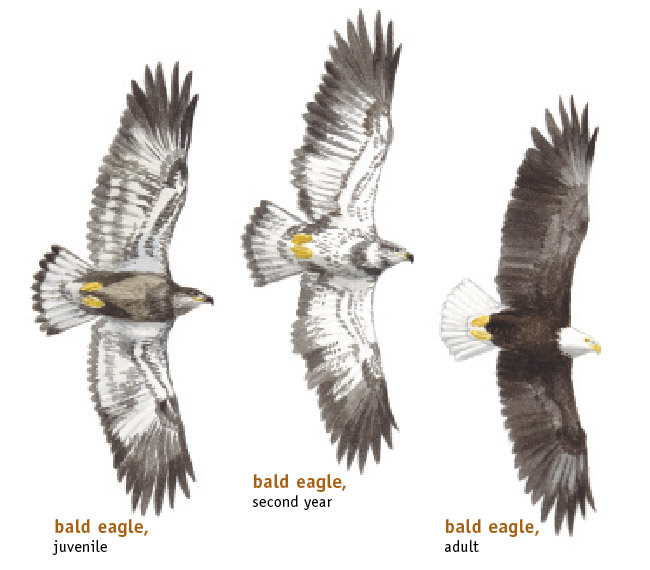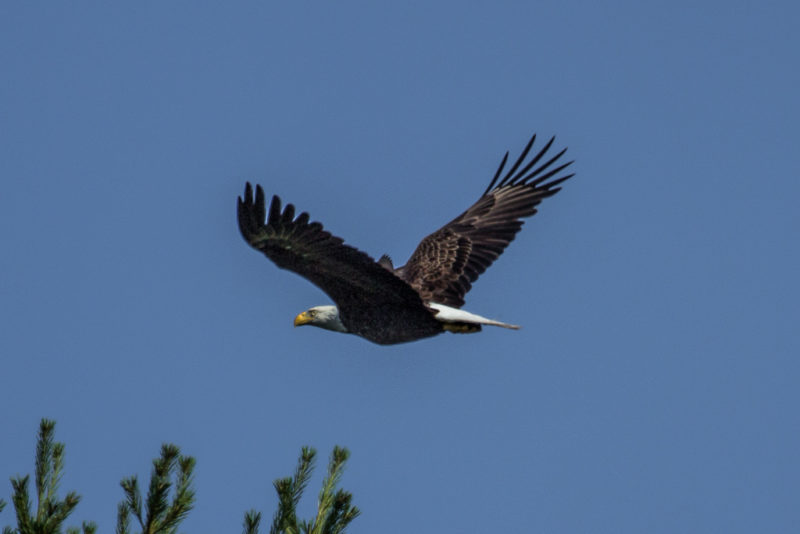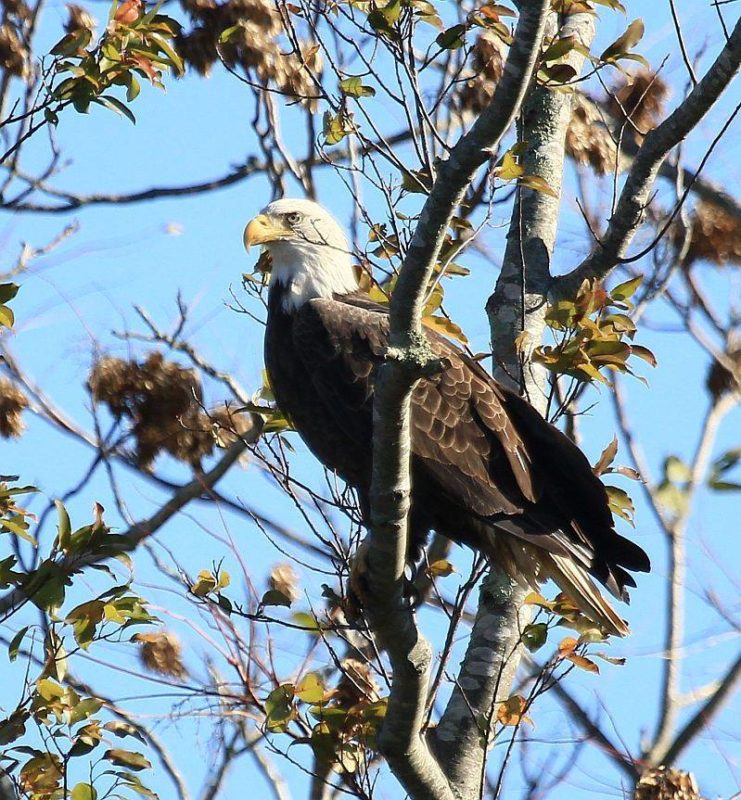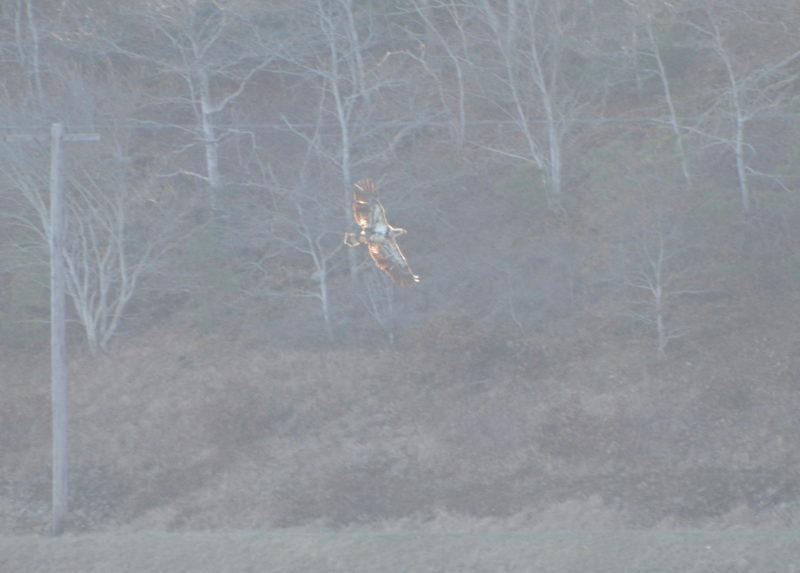10 places to look for bald eagles in southeastern Massachusetts
After their brush with extinction in the 20th century, bald eagles are beginning to return to the Buzzards Bay region, thanks to strong protections and a successful reintroduction program. If you haven’t seen one around here already, then look out – these majestic raptors are becoming more common, soaring over ponds, rivers, and salt marshes from Fall River to Falmouth.
Where might you see a bald eagle around southeastern Massachusetts? Although we can’t guarantee you’ll spot one of these elusive birds if you go looking, it’s always worth a try! Here are a few suggestions for places to look for bald eagles at local parks, trails, and waterways across Buzzards Bay, as well as some helpful tips on how to identify an eagle.
How do I identify a bald eagle?
Bald eagles are often confused for other raptors, such as ospreys and red-tailed hawks. But there are a few key ways you can confirm that what you’re seeing is an eagle:

Bald eagles go through several color changes before reaching adulthood in their fourth year. (Image: Bird Watcher’s Digest)
- Color (adults): It’s easiest to identify fully mature bald eagles by their distinctive snowy white head and tail, set against a brown body and bright yellow bill, eyes, and feet.
- Color (juveniles): Immature bald eagles (under four years old) are harder to distinguish because they cycle through a series of different-colored features that look similar to other species. During their first three years, bald eagles have a flecked brown and white body with a dark bill and eyes.
- Size and shape: Although bald eagles change color drastically as they age, their size and shape doesn’t change much. Bald eagles are the largest raptor in Massachusetts, so they have a noticeably heavier body, larger head, and wider wingspan than other birds that fly with heavy, slow wingbeats.
- Flight: Unlike ospreys (which fly with their wings in an M-shape) or turkey vultures (which fly with their wings in a V-shape) bald eagles hold their wings completely flat like a board. They often soar in broad, sweeping circles.
- Season: Bald eagles and ospreys are often found in the same coastal habitats. Time of year is one surefire way to tell these two species apart: Eagles live in Massachusetts year-round, whereas ospreys migrate south for winter in September and don’t return to Buzzards Bay until March.
Where can I look for bald eagles around Buzzards Bay?
In the Buzzards Bay region, bald eagle nests are located at Assawompset Pond in Lakeville, Watuppa Pond in Fall River, and Halfway Pond in Plymouth. These protected inland pond systems provide clean water and secluded shorelines for eagles to nest, breed, and thrive. Bald eagles build massive nests in large, tall trees near water, and the same pair returns to the nest every winter.
Winter is a particularly good time to look for bald eagles. That’s when many of them migrate away from inland ponds to coastal areas like Buzzards Bay in search of food. Look for eagles soaring over the water or perched in trees along rivers and salt marshes as they hunt for fish, ducks, and the occasional turtle or mammal carcass.
Here are 10 places around southeastern Massachusetts where bald eagles have recently been spotted. If you’re quiet, patient, and a little bit lucky, you might see one yourself!
1. Southeastern Massachusetts Bioreserve (Fall River)
The vast Southeastern Massachusetts Bioreserve protects the land surrounding Watuppa Pond, where a pair of bald eagles nests each year. To get a walk in with your eagle watching, head to the Tattapanum Trail, part of the city of Fall River’s Watuppa Reservation. This easy wooded path is located right next to the head of North Watuppa Pond, where you can get a great view of the pond facing south.
2. Westport Town Farm (Westport)

Look for mature bald eagles soaring over Assawompset Pond in Lakeville from the shores of Betty’s Neck. (Image: lapre93/Flickr)
In 2015, researchers found that a pair of bald eagles had taken over an old osprey nest on the upper East Branch of the Westport River near Hix Bridge Landing. (The nest was quickly reclaimed by its original osprey owners the following spring.) Whether eagles are nesting here or not, nearby Westport Town Farm is a fantastic place to try and spot an eagle on the river any time of year. The property’s easy one-mile loop trail leads to a beautiful shoreline view of the East Branch.
3. Betty’s Neck (Lakeville)
There are two pairs of nesting bald eagles around Betty’s Neck, part of the 4,000-acre Assawompset Pond Complex. The clear waters of Assawompset and Pocksha ponds make it easy for bald eagles to find fish. Follow the trail at Betty’s Neck up to Jeremy’s Point, about a 1.5-mile round-trip walk, to look for bald eagles among the pond’s forested shoreline.
4. Acushnet River (New Bedford/Acushnet/Fairhaven)

In winter, bald eagles are frequently seen on the urban Acushnet River, including in Acushnet, New Bedford, and Fairhaven. (Image: Chip Davenport/New Bedford Guide)
Bald eagles in the city? You’d better believe it! Despite heavy development along the Acushnet River, there have been several sightings of bald eagles in New Bedford, Acushnet, and Fairhaven in recent years. The Sawmill in Acushnet and Rivers End Park in New Bedford are two places to watch out for eagles.
5. The Bogs (Mattapoisett)
Scattered freshwater wetlands and the nearby Mattapoisett River make The Bogs a great place for bald eagles to frequent. Volunteer trail stewards have seen bald eagles here multiple times – sometimes swooping in to harass ospreys for their food! Keep an eye out for this spectacular display as you walk the extensive trail network around the bogs and wetlands.
6. Brandt Island Cove District (Mattapoisett)
Surrounded by protected salt marshes, Brand Island Cove is an ideal spot for bald eagles to hunt for food. You might see one from Brandt Island Cove District, a Mattapoisett Land Trust property with a scenic half-mile trail out to the water. Stop at the bird observation platform for a clear view of the marshes and coastal forests, where you might spot an eagle among the osprey stands.
7. Myles Standish State Forest (Carver/Plymouth)
Bald eagles can’t resist an easy meal, and a trout-stocked pond fits the bill! Residents from nearby Halfway Pond are often seen feasting on trout from Fearing Pond at Myles Standish State Forest, particularly in early summer when water temperatures rise. Head to Fearing Pond from one of the state forest’s many roads, trails, and bike paths.
8. Halfway Pond Conservation Area (Plymouth)
The heavily wooded, protected island in the middle of Plymouth’s Halfway Pond is closed off to humans, making it a great spot for bald eagles to live. A nesting pair of eagles was discovered here in 2013, and since then the pond has become a prime spot for eagle-watching. Head to Halfway Pond Conservation Area and set off on foot toward Big Point Trail, which hugs the pond’s shoreline and offers a panoramic view of the island through the trees. If you have a canoe or kayak, there is a small put-in at the edge of the pond so you can get out on the water and take a closer look.
9. Cape Cod Canal (Bourne)

The Cape Cod Canal is a prime destination for wintering bald eagles, like this immature one flying overhead. (Image: Peter Crosson/Flickr)
The clear waters of the Cape Cod Canal attract lots of fish, ducks, and sea birds – choice meals for wintering bald eagles. There are several places along the canal you can go to look for them. Head to Herring Run Recreation Area, where fish migrate upstream from salt water to fresh. Or try one of the bridges; bald eagles sometimes perch underneath to watch for prey on the water. Buzzards Bay Recreation Area and Tidal Flats Recreation Area are set on either side of the railroad bridge, while Bourne Recreation Area is located right underneath the Bourne Bridge on the Cape side.
10. Great Sippewissett Marsh & Black Beach (Falmouth)
Bald eagles from the north overwinter along the coast of Cape Cod, particularly in lush natural places like Falmouth’s Great Sippewissett Marsh. Several local birders have spotted immature bald eagles at this Cape Cod birding hotspot, particularly in winter. The best public place to view Great Sippewissett Marsh is the Shining Sea Bikeway, just south of Chapoquoit Road.